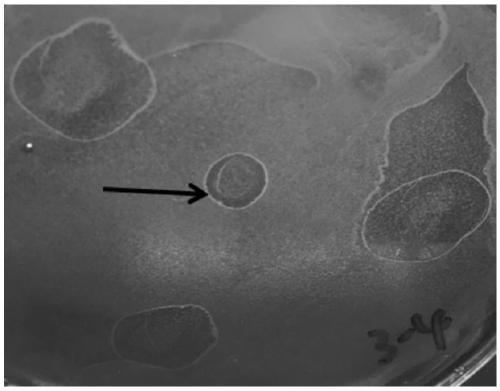Vibrio parahaemolyticus bacteriophage and application thereof
A technology of Vibrio hemolyticus and bacteriophage, applied in the direction of bacteriophage, virus/phage, application, etc., can solve the problem of narrow lysis spectrum, and achieve the effect of strong thermal stability, reduced number of bacteria, and wide lysis spectrum.
- Summary
- Abstract
- Description
- Claims
- Application Information
AI Technical Summary
Problems solved by technology
Method used
Image
Examples
Embodiment 1
[0021] Determination of phage lysis profiles
[0022] Activate different bacterial single colonies to the logarithmic growth phase, respectively take 200 μL of the bacterial solution and drop it on the 2216E solid medium plate, then spread the bacterial solution evenly with a sterile applicator until absorbed, take 10 μL of the phage stock solution and drop it on the The surface of the 2216E solid medium plate was placed in a clean bench for 30 minutes and then placed in a 37°C incubator for 8 to 12 hours. Observe whether there are phage plaques on the surface of the plate. Clear plaques indicate that the host is sensitive to phages, and absence of plaques indicates that the host is insensitive to phages. The results of the cracking spectrum experiment are as follows: Figure 1~3 shown, where figure 1 is the cracking effect of phage on VP-DYW29, figure 2 The lytic effect of phage on VP-ZH 3-4, image 3 For the cracking effect of phage on ATCC17802, it can be seen that th...
Embodiment 2
[0024] Phage thermostability assay
[0025] Take a titer of about 10 8 1.0mL of pfu / mL phage solution was placed in a sterile EP tube, and reacted in a constant temperature water bath at 27, 37, 47, 57, and 67°C for 1h, and after the action time was over, it was taken out, serially diluted by 10 times, and then diluted with double Counting was carried out by layer plate method, and the average value was obtained by repeating three times, and the change of phage titer was observed.
[0026] Experimental results such as Figure 4 As shown in the results, it can be seen that the phage can tolerate the temperature environment of 27°C to 57°C, and the titer of the phage does not change much when it is acted at 27°C to 57°C for 1 hour, and the titer of the phage is reduced to 0 when it is acted at 67°C for 1 hour, indicating that the separation The obtained phage can tolerate higher temperature in the environment.
Embodiment 3
[0028] Evaluation of the bactericidal effect of phages on Vibrio parahaemolyticus in fish samples
[0029] Phage titer: 10 7 pfu / mL, 100 μL; Vibrio parahaemolyticus count: 10 7 cfu / mL, 100 μL.
[0030] The test is divided into a test group and a control group, and the specific detection steps are as follows:
[0031] 1) Cut the fish meat with the skin removed into small pieces (about 1g) with an area of 2*2cm, put the meat pieces over a flame and put them in a disposable plate for later use;
[0032] 2) Evenly spread 100 μL Vibrio parahaemolyticus solution on the surface of the meat piece;
[0033] 3) After 15 minutes, add 100 μL of phage to the surface of the fish in the test group, and add 100 μL of phage to the control group instead of adding phage;
[0034] 4) Place the prepared samples at 25° C., count Vibrio parahaemolyticus at 1 h, 2 h, 3 h, 6 h, and 12 h.
[0035] Test results such as Figure 5 As shown, it can be seen from the results that after the applicatio...
PUM
 Login to View More
Login to View More Abstract
Description
Claims
Application Information
 Login to View More
Login to View More - R&D Engineer
- R&D Manager
- IP Professional
- Industry Leading Data Capabilities
- Powerful AI technology
- Patent DNA Extraction
Browse by: Latest US Patents, China's latest patents, Technical Efficacy Thesaurus, Application Domain, Technology Topic, Popular Technical Reports.
© 2024 PatSnap. All rights reserved.Legal|Privacy policy|Modern Slavery Act Transparency Statement|Sitemap|About US| Contact US: help@patsnap.com










